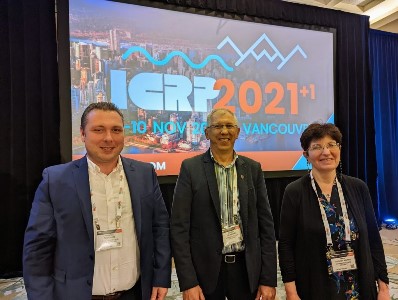
6th International Symposium on the System of Radiological Protection, Vancouver, Canada, November 7-10, 2022

Three USTUR faculty members attended the International Commission on Radiological Protection (ICRP) meeting in Vancouver, where Maia Avtandilashvili presented an electronic poster about a proposed human respiratory tract model that uses scar tissue compartments, instead of chemical binding, to describe long-term retention of plutonium.
Human respiratory tract model to describe long-term retention of plutonium using scar tissue compartments
Maia Avtandilashvili (USTUR), Deepesh Poudel (LANL), Luiz Bertelli (LANL), John Klumpp (LANL), Sergei Y. Tolmachev (USTUR)
Mechanisms associated with certain parameters of the Human Respiratory Tract Model (HRTM), which is described in Publication 130 of the International Commission on Radiological Protection, have a significant impact on retention of radionuclides in different regions of the respiratory tract and resulting tissue doses. Animal experiments and human autopsy studies have demonstrated that a small fraction of inhaled plutonium may be retained in the respiratory tract long after an inhalation intake, even if the inhaled material is very soluble. The HRTM provides two mechanisms to account for retention of the material with little to no particle transport or absorption into blood: deposition of the material in sequestered compartments, and ‘binding’. The latter refers to a process where a fraction of the dissolved material chemically binds to the airway wall tissue. For plutonium, bound fraction (fb) is assumed to be 0.2%. The United States Transuranium and Uranium Registries obtained data on plutonium activity and concentration in bronchial, bronchiolar, and alveolar-interstitial regions from four workers who were exposed to plutonium materials with solubility ranging from soluble nitrate to very insoluble ‘high-fired’ oxide. Significantly more plutonium was found to be retained in the upper respiratory tract of these individuals than was predicted by the current biokinetic models. Modification of the model parameters, including fb, was unable to explain the data for one individual who inhaled an insoluble form of plutonium. Moreover, several studies show evidence of large amounts of plutonium encapsulated in scar tissues of humans and experimental animals, pointing to an alternate mechanism for retention in the respiratory tract. The modified HRTM with the addition of scar-tissue compartments was proposed to describe the long-term regional retention of plutonium in the respiratory tracts of all four individuals. The transfer rates to scar-tissue compartments were determined using Markov Chain Monte Carlo analysis of the bioassay and post-mortem tissue analysis data, considering the uncertainties associated with deposition, dissolution, and particle clearance parameters. Data analysis showed that a significant amount of plutonium, 20-100%, retained in the respiratory tract, was sequestered in scar tissues, depending on the solubility of the inhaled material. Since scar tissues prevent irradiation of more sensitive cells by absorbing most of the energy from alpha emissions, retention of plutonium in scar tissues is unlikely to contribute to the lung dose as significantly as binding. [USTUR-0619-22A]